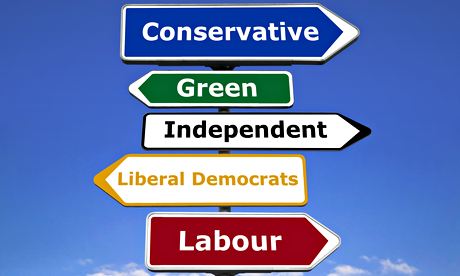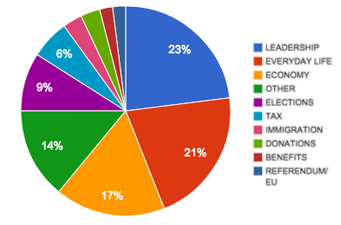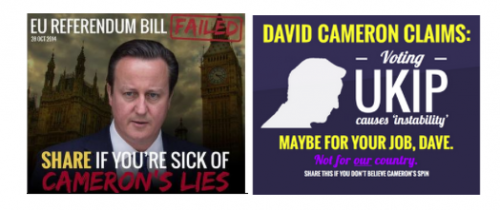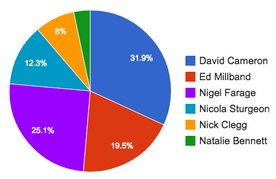Who’s winning? The UK's Social Election
The UK’s general elections used to be a reasonably predictable affair. Historically, there were a number of things that always seemed to hold true:
- No incumbent Government ever increases their share of vote
- No opposition party ever wins an election without leading in economy and leadership polling (Labour is currently behind on both)
- Scotland is a Labour stronghold; the South East a Conservative one
But this year, we’re facing new factors we’ve never had to deal with before. The incumbent is the first peacetime coalition and we’re at an all time low of party membership; not to mention the growing popularity of The Green Party, UKIP and the SNP making it a six party system and of course, the potential impact and influence of social media.
In 2010 many were excited at the prospect that social media could play within that election. As it turned out, it was a bit of a damp squib on social. The election was still dominated by traditional media – notably the Leadership Debates and Gordon Brown’s unguarded comments whilst unaware he was still being recorded.
More recently social media has played a part in galvanizing the vote in the Scottish referendum but came unstuck when used to predict on outcome. According to some reports Alex Salmond was drafting his victory speech on the basis of social listening indicating a Yes win when it became clear the No campaign had snatched it.
Even so, social is an incredibly useful tool for parties to spread their messages and capture voters’ support, even if not for predictions of who might eventually win. I’ve been waiting (and still am…) for a UK political party to use social in a truly innovative way that leverages an existing human behaviour and makes a lasting impact on the election.
As you may have read in PR Week or The Drum, we’ve been looking at how the political parties have performed on social channels over the three months to January 2015. With less than 100 days till the General Election, how successful have they been in capturing the online, social audience?
The Conservative Party
The Conservative Party has a presence on all the major social media channels, but focuses on Facebook and Twitter – to varying degrees of success.
Facebook is more integrated into their communications strategy than Twitter, with the majority of posts in the last six months linking back to the press room on their web site. This is an efficient posting strategy; posting links automatically pull through an image and should help combat the reduced reach of other types of content on the platform.
The Page relies heavily on David Cameron in his role as Prime Minister, as expected when the party is performing well on Leadership in the polls. The split of their content focuses on their perceived strengths – leadership and the economy and tackling an area where they’ve been accused of lacking (everyday life):
Conservative Party: Content Pillars on Facebook
The party is less successful on Twitter. Twitter users tend to be more left leaning than right and the Conservatives seem to understand this, and focus less on the platform. The party posts less than any other party we analysed (on average 1.5 posts per day – compared to 8-15 posts from other parties). 70% of Tweets are retweets of David Cameron’s Prime Ministerial account and, as a result, the tone of voice is very formal and it struggles to fit content within its 140 character limit. It seems to be difficult to be statesmanlike on Twitter.
The Labour Party
Labour has a similar posting frequency on Facebook as the Conservatives with a similar number of per post interactions. It publishes across a more balanced number of content pillars – top themes include “cost of living / everyday life” and the NHS, reflecting its key manifesto points.
There’s also a focus on driving party membership and donations and there are links to polls for feedback on its web site – something no other party appears to be doing. The top three posts are all negative in nature, attacking the Conservatives (the party itself rather than Cameron or their specific policies), and all the posts contain a strong call to action to share. In this way, the content appeals to the core Labour voter rather than the broader public like the Conservatives.
On Twitter, Labour feels more at home – perhaps because Twitter itself has more left-leaning audience. The content it produced is tailored to the platform. Images are cropped correctly and there’s a more relaxed tone of voice that fits into the short-form content, probably because it doesn’t quote Ed Miliband as heavily as much as the Conservatives do David Cameron.
UKIP
UKIP receives the most @mentions than any other party on average on Twitter – partly due to having their first two MPs elected to Parliament in the timeframe we analysed. It also had the fastest Facebook community growth rate over that period, too.
Like all challenger parties it attempts to differentiate itself from the establishment and the Page pretty much achieves that – both in the direction of the content (incisive negative attacks against the Conservatives) and look and feel / tone of the content.
The content particularly lacks a corporate sheen and has more of a fan community feel which fits the everyman angle Farage is trying to exploit. Cleverly, the page rounds up all of Nigel Farage’s comments at the end of the week for a #FarageonFriday post so the content is not overly dominated by him.
On Twitter, the party also does reasonably well, coming a joint second in terms of community growth. And in terms of party leaders, Farage is producing more Twitter conversation than any other party leader.
Party Leaders: Share of Voice on Twitter
The Liberal Democrats
If the last five years have been bruising for the Lib Dems offline, recent social media performance doesn’t bode well for the future. On Facebook, it has the smallest community and the second slowest growth over the last six months. On Twitter, it is only the fourth largest party (behind the Conservatives, Labour and the Greens) with the second slowest growth.
Across both platforms, they talk about topics like mental illness and the death penalty in the US, which, while important to many voters, do not give it the feel of a party gearing up to fight an election. Perhaps the party has decided the best strategy to avoid criticism on social is to choose a socially accepted position on a topic in the UK and promote it. Also, the Lib Dems often refer to themselves in the third person, giving the content a corporate feel.
The Green Party
The Green Party has a small community on Facebook and feels more than a regional / local party rather than a national party, though its growth has been strong. However, the second largest content bucket for The Page is “Other” – content that is hard to categorise into clear pillars, giving the page a slightly random feel. The other largest content buckets are Leadership and the Environment – to be expected.
The Greens see UKIP as their natural opponents and any negative campaigning is directed at that party. In contrast UKIP targets both the Conservatives and The Labour party in its negative campaigning, highlighting who it sees as its main opposition.
On Twitter, the Greens perform better and had the highest community growth in the time frame analysed (albeit from a lower base). The party is very active, posting around 15 Tweets per day – a lot of them retweets of Caroline Lucas, Natalie Bennett and online news outlets. These Tweets promote the Green Party as the party of choice for the youth in society.
The SNP
The SNP’s social media strategy is the anomaly amongst the parties having been on a campaign footing for the last 18 months or so. Even after the Scottish Referendum, fall out from this impacted its activity – skewing the number of the interactions (upwards) on Facebook and Twitter.
On Twitter, the SNP remains the smallest party – similar to those in power south of the border, its Twitter handle relies heavily on its leader for content, meaning it suffers a similar fate as the Conservatives, coming across as overly formal in the 140 character length.
Where do we stand?
There really is no stand-out party on social media at the moment; all parties could be using social media to communicate and engage in much deeper ways with voters. Current Twitter conversation volumes show that UKIP has stolen a march on the larger parties, partly due to having their first two MPs elected to Parliament in that timeframe. Across its social channels, UKIP looks to be a strong challenger brand, getting its tone of voice right for its audience.
However, looking at this in a more holistic manner, Labour seems more at home than most other parties on Twitter, with a consistent tone of voice and wide reach, talking about the issues that matter to the public. However, using this as a prediction for any kind of result at the election is dangerous at this stage, especially given that most social media predictions were dramatically wrong about the Scottish Referendum.
On Facebook, the Conservative Party’s content is more engaging than Labour’s and appeals to a wider audience. However, Twitter doesn’t feel like a natural home for the Tories; they’re too formal and have a much lower posting frequency than the other parties.
So, at the moment on social media, it’s the challenger parties that seems to be making a play for the potential voters on social with The Green Party and UKIP performing well, albeit, often from a smaller base making percentage growth easier. While the SNP’s growth has been fairly strong, they are hard to judge because their social channels have been positively affected by the Referendum even after September.
When looking at the main political parties it’s a draw between The Conservatives and Labour – one outperforming the other on Facebook and Twitter respectively. Overall, The Lib Dems appear to be out of the social media race and the SNP is an unknown. So very much like the election in general, the social media performance of the parties make it difficult to pick a winner with any degree of certainty.




